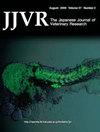Can procalcitonin be used as a clinical biomarker during bacterial, viral and parasitic infections in dogs?
IF 0.3
4区 农林科学
Q4 VETERINARY SCIENCES
引用次数: 3
Abstract
The aim of this study is to investigate the usability of serum procalcitonin level in dogs as a clinical biomarker for the distinction between bacterial, viral, and parasitic diseases. A total of 160 dogs were used. The animals were evaluated in four groups as control and those with bacterial, viral, and parasitic infections. Serum procalcitonin, tumor necrosis factor-alpha (TNF- α ), interleukin-1 beta (IL-1 β ), interleukin-6 (IL-6), interferon-gamma (IFN- γ ) level, and total white blood cell (WBC), and differential leukocyte count were determined. Serum procalcitonin level was found to be higher in dogs with bacterial infection compared to the control group and dogs with viral disease ( P = 0.019). It was observed that serum procalcitonin level in dogs with bacterial infection varies related to the disease agent and it was found higher in those with pyometra ( P = 0.009). Serum procalcitonin level was higher in dogs which had parasitic infections but, the difference is not significant. IL-6 level was found higher in dogs with viral and parasitic diseases than those in the control ( P = 0.006). A negative correlation was determined between procalcitonin and IFN- γ ( P = 0.001). While a positive correlation was detected between procalcitonin and WBC count, a negative correlation was determined between procalcitonin and monocyte percentage. In conclusion, serum procalcitonin level can be used as a clinical biomarker in bacterial diseases and, perhaps, in some parasitic diseases in dogs. However, further studies should be conducted to determine threshold values that take the severity of infection, its prevalence, and clinical course into account.降钙素原能否作为犬类细菌、病毒和寄生虫感染的临床生物标志物?
本研究的目的是研究犬血清降钙素原水平作为区分细菌性、病毒性和寄生性疾病的临床生物标志物的可用性。总共使用了160只狗。这些动物被分为四组进行评估,分别是对照组和细菌、病毒和寄生虫感染组。测定血清降钙素原、肿瘤坏死因子- α (TNF- α)、白细胞介素-1 β (IL-1 β)、白细胞介素-6 (IL-6)、干扰素- γ (IFN- γ)水平,以及白细胞总数(WBC)和差异白细胞计数。细菌感染犬的血清降钙素原水平高于对照组和病毒感染犬(P = 0.019)。细菌感染犬血清降钙素原水平与疾病病原相关,脓脓病犬血清降钙素原水平较高(P = 0.009)。寄生虫感染犬血清降钙素原水平较高,但差异不显著。病毒和寄生虫病犬IL-6水平高于对照组(P = 0.006)。降钙素原与IFN- γ呈负相关(P = 0.001)。降钙素原与白细胞计数呈正相关,降钙素原与单核细胞百分比呈负相关。综上所述,血清降钙素原水平可作为细菌性疾病和某些寄生虫病的临床生物标志物。然而,应该进行进一步的研究,以确定考虑感染严重程度、患病率和临床病程的阈值。
本文章由计算机程序翻译,如有差异,请以英文原文为准。
求助全文
约1分钟内获得全文
求助全文
来源期刊
CiteScore
1.00
自引率
0.00%
发文量
0
审稿时长
>36 weeks
期刊介绍:
The Japanese Journal of Veterinary Research (JJVR) quarterly publishes peer-reviewed articles on all aspects of veterinary science. JJVR was originally published as a “University Journal” of veterinary science at Hokkaido University from more than 60 years ago. Currently, JJVR, is Japan’s leading scientific veterinary journal, and provides valuable information for the development of veterinary science by welcoming contributions from researchers worldwide.
JJVR offers online submission for Regular Papers, Short Communications, and Review Articles that are unpublished and not being considered for publication elsewhere. Research areas include:
Anatomy, Physiology, Biochemistry, Pharmacology, Microbiology, Infectious diseases, Parasitology, Laboratory Animal Science and Medicine, Internal Medicine, Surgery, Pathology, Theriogenology, Molecular Medicine, Public Health, Radiation Biology, Toxicology, Wildlife Biology and Medicine, Veterinary Hygiene, The other fields related to veterinary science.

 求助内容:
求助内容: 应助结果提醒方式:
应助结果提醒方式:


